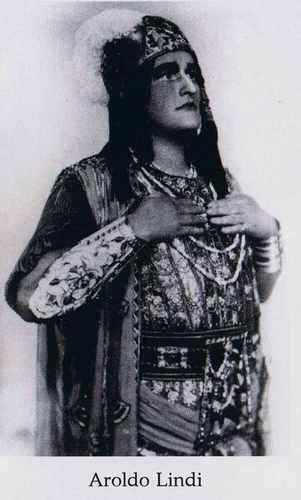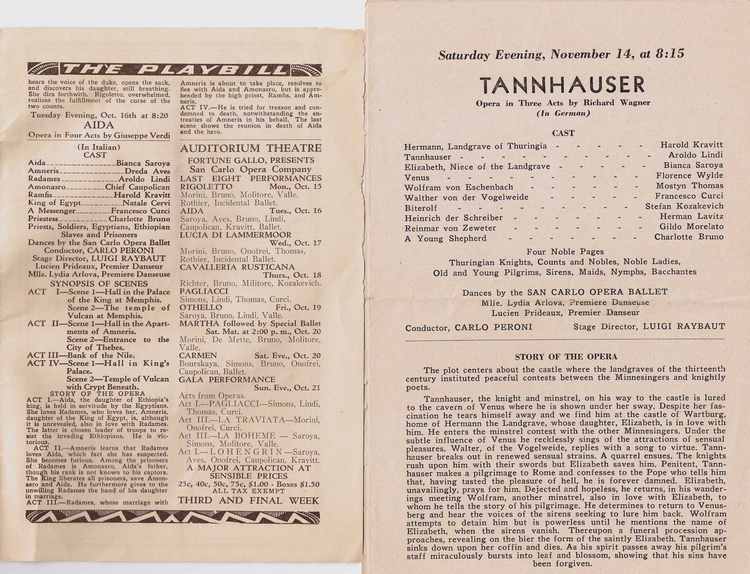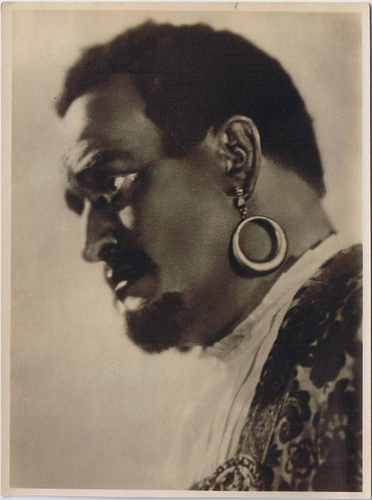

Malley Keelan Family & Friends Concerts
John McCormack--Ireland's Greatest Tenor
Frank Patterson--Ireland's Golden Tenor
Richard Crooks--Tenor Voice of Firestone
Richard Tucker--America's Famed Verdi Tenor
|
Some great tenors emerged from Sweden in the last century--Set Svanholm, Jussi Bjoerling, Nicolai Gedda and Gosta Winbergh come to mind --but few have been dramatic tenors who made a name in the Italian repertoire. Aroldo Lindi is one such singer. Nearly forgotten by all but the most enthusiastic of opera devotees, Aroldo Lindi deserves to be remembered alongside some of his more illustrious colleagues of the period. During the 1920s, 1930s and until his death on stage in 1944, Lindi was one of a rare breed of tenore di forzas that followed in the steps of 19th century's Francesco Tamagno. Giovanni Zenatello, Leo Slezak, Giovanni Martinelli, Aureliano Pertile, Francesco Merli, and John O'Sullivan in the first half of the 20th century, and Galliano Masini, Mario Fillippeschi, Mario del Monaco, Kurt Baum, Ramon Vinay, Jon Vickers, Franco Corelli and James McCracken after 1940 and into the 1980s--real "Italianate" dramatic tenors capable of singing the heavy Verdi roles like Radames, Manrico, Don Alvaro and Otello; the French roles such as Samson, Don Jose, Arnold, Raoul, John of Leyden and Eleazar; the verismo roles like Canio and Andrea Chenier, and the heavier Puccini roles of Des Grieux, Dick Johnson and Calaf. This breed of tenor has the capability of giving these roles the full visceral impact they deserve and demand, replete with steel or bronze-colored high notes and seemingly unstinting vocal stamina. There are few, if any, in their class in our own present age of opera--perhaps Jose Cura. Other estimable tenors of the 20th century including Caruso, Gigli, Lauri-Volpi, Peerce, Bjoerling, Bergonzi, di Stefano, Gedda, Tucker, Domingo, Pavarotti and Carreras, to name a few, were either heavy lyric, lyric-spinto or heavy spinto tenors who often essayed the heavier roles, to greater or lesser degress of success. In fairness to them they often brought a much-needed and often-neglected lyricism that the dramatic tenors occasionally lacked. And, of course, Enrico Caruso was really in a class of his own, alternating lyric Nemorino with spinto Cavaradossi and dramatic Don Alvaro and Eleazar up to his last years. Born in Sweden in 1888, Gustav Harald Lindau showed an early interest in sports, especially boxing. He also sang as a youth in the area in a soloist and in a "popular music" trio. He later travelled to Italy where he studied opera and began a much-lauded career over the next thirty years that took him around the world to most of the major and minor opera houses and auditoriums where grand opera would be presented. Gradually the Italianate form of his name emerged on programs--Aroldo Lindi--for which he was known the rest of his life and career. Lindi became a valuable addition to the Royal Opera in Covent Garden, La Scala, Chicago, Boston and San Francisco Operas and other major venues in the 1920s, singing with major soprano stars such as Eva Turner, Margaret Burke-Sheridan, Luisa Pampanini, Gianna Lorangi-Lombardi, Gina Cigna, Claudia Muzio and Maria Jeritza. Similarly, he sang with many great mezzos, baritones and bassos of the era. Lindi later was the star tenor touring with Fortune Gallo's San Carlo Opera Company during the 1930s until his death in 1944. I have several of the programs, notably from Omaha. Notable career highlights for Lindi included premiering the role of Calaf in Turandot in many important cities, including Barcelona, Pisa and Chicago, soon after the world premiere. He was also part of the festivities of the opening of Radio City Music Hall in 1932. While singing Radames in Cairo, Egypt in the late 1920s he was presented with one of the original handmade costumes for that character, from the 1871 premiere. I'm sure it didn't fit the strapping Swede, but it was a notable gesture, all the same! The distinction of recording the complete role of Radames in his vocal prime (1928--he was 40) fell to him with a spectacular cast of its day--Giannina Arangi-Lombardi, Maria Capuana, Armando Borgioli and the legendary basso Tancredi Pasero, at La Scala, with Lorenzo Molajoli conducting. One of the first complete recorded operas of any kind, it has been reissued on VAI compact disc 1083-2 and I cannot recommend it highly enough. It is a style of Verdi singing now gone, regretful to say. Hear Lindi sing Celeste Aida-- http://www.youtube.com/watch?v=izFlsdRYJnE
Vesti la giubba--http://www.youtube.com/watch?v=lnSNg4KSQrO and Tosti's song Good-Bye http://www.youtube.com/watch?v=RGhxrTL24gY
Sadly, Aroldo Lindi died in 1944 at age 55 onstage in San Francisco's War Memorial Opera House, during a performance of Pagliacci, singing Canio's lament "Vesti la giubba." A truly dramatic "way to go." Aroldo Lindi's nephew, Richard Lindau, has worked untiringly to promote the tenor's life and legacy. I have asked him about his memories of his uncle, whom he heard on stage in 1930s and in the Lindau home when the tenor visited. Here is a summation of his reply. The parenthetical phrases are mine. Hello Malley, As to remembering Lindi on stage, the most memorable would be waking up during Trovatore in NYC Centre Theatre, yelling out loud 'they stabbed Uncle Lindi!' I can recall also the Hippodrome in NYC, but not the opera I saw (probably Aida, with the San Carlo Opera). Probably slept through that also. Samson in Hartford scared the daylights out of me when we met Lindi backstage with all his make-up on. We saw Carmen in the Boston Opera house, but my brother and I were not allowed to attend a party afterward. These are the weird things that stand out in this fading memory. Do I wish I had those chances again! I remember an oratorio in the Saengerbund in Hartford, but as usual was not greatly impressed because of the lack of costumes. My most vivid recollection of the tenor was his practicing of "On the Road to Mandalay" at our home. I never asked why that piece. If only I could have it to do over. As to what was he like...to us, just a wonderful uncle. Unassuming and modest. We didn't realize what a world class opera singer was, and he wasn't about to tell us. I'm not sure what tenorish is, but if it implies as to sopranos, prima donna, no, he was humble, if anything. Yes, a regular guy. Yes, I heard my uncle sing many times, in the Center Theatre and the Hippodrome in NYC, Boston Opera House, and the Bushnell Memorial in Hartford, our home town. But maybe the most memorable would be he and Mostyn Thomas joining the parishioners in our church for the first hymn. The looks of amazement at (page 5 of the Lindi site shows Mostyn Thomas at the bottom as Amonasro in Verdi's Aida. Also, listen to this interview with Thomas about recording in those days.) http://www.bbc.co.uk/wales/walesonair/database/mostyn.shtml (I agree with this assessment regarding the Celeste Aida--it is rough and he is not at his best. But Lindi shines in all the other music, especially Act III, with Arangi-Lombardi and Borgioli. This complete set was released at the same time as the much more famous Act III on RCA Victor from the same year with Elisabeth Rethberg, G. Lauri-Volpi and G. de Luca. Time Magazine at that time reviewed both, giving the RCA set the nod,while praising the Columbia set. I disagree--I think the Italian/Swedish cast is much better. Just my opinion!--MK) I have a dozen or so music scores of Lindi's, notes and all. Included is one "La Cena delle Beffe', by Giordano. Have you ever heard of this? Also puzzling are the scores of Lohengrin, which I'm sure he performed, Lucia Di Lammermoor, and Manon Lescaut. The latter is mentioned in a letter from Lindi to his first wife, while studying in Italy, early 1920's. best, Richard I appreciate Richard's insights into this excellent singer's career and personality. It is a rare link to have someone connected to a singer that far back. Here are some photos of Aroldo Lindi I hope you will enjoy: |
||
 Aroldo Lindi as the Egyptian warrior captain Radames in the Verdi opera. He is said to have sung it over 1,000 times! In 1928 he recorded it for Columbia with a superb cast. It is available on VAI compact disc. The CD label TimaClub offers a CD of Lindi singing opera arias, from the acoustic and electrical periods of the 1920s. At one time OASI offered an Lp of his 78 records. Lindi was fortunate to be recorded by Columbia in his prime years, his 30s and early 40s.
|
||
 Two program pages from the San Carlo Opera Touring Company of the Americas, Fortune Gallo, impresario. As you can see, Lindi was a valued member, carrying the load of the heaviest tenor roles. The program to the left is from Oct., 1934, in Chicago, showing most of their 10-day engagement. Lindi is slated for Pagliacci, Otello and Aida--in the same week! He once sang a matinee of Pagliacci and then Manrico in Il Trovatore that evening! The Tannhauser dates from Nov., 1936, in Omaha. Gallo took pride in it being a true commerical enterprise without any government funding, and they were always "in the black," even during the Great Depression. Thousands of music lovers had their first "live" opera experience by attending a SCO performance. The production values were often second or third-rate, with well-worn canvas sets and aging costumes by the 1930s, but performances were in the original languages, and many of the artists were first and second rank, who would grace any stage today. Gallo & Co. was truly an old-fashioned touring repertoire ensemble playing in off-season opera houses and auditoriums, bringing "opera to the masses and not the classes" from 1913-1955. |
||
 Sweden's "Moor of Venice"--the legendary Aroldo Lindi as Verdi-Boito's "Otello." His three records of music from the opera give us a perfect aural picture of how stunning his powerful voice was in this challenging music, considered to be the penultimate Italian dramatic tenor role. photo courtesy of Richard Lindau |
||
